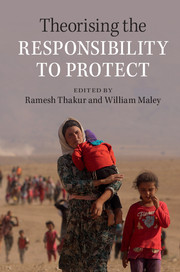Book contents
- Frontmatter
- Contents
- List of figures
- Notes on contributors
- Part I Context
- Part II The Responsibility to Protect, normative theory and global governance
- Part III The Responsibility to Protect and international social purposes
- 12 United Nations peacekeeping and the Responsibility to Protect
- 13 Humanitarian law, refugee protection and the Responsibility to Protect
- 14 Is the Responsibility to Protect doctrine gender-neutral?
- 15 The Responsibility to Protect: a Western idea?
- 16 Colonialism and the Responsibility to Protect
- Index
12 - United Nations peacekeeping and the Responsibility to Protect
from Part III - The Responsibility to Protect and international social purposes
Published online by Cambridge University Press: 05 August 2015
- Frontmatter
- Contents
- List of figures
- Notes on contributors
- Part I Context
- Part II The Responsibility to Protect, normative theory and global governance
- Part III The Responsibility to Protect and international social purposes
- 12 United Nations peacekeeping and the Responsibility to Protect
- 13 Humanitarian law, refugee protection and the Responsibility to Protect
- 14 Is the Responsibility to Protect doctrine gender-neutral?
- 15 The Responsibility to Protect: a Western idea?
- 16 Colonialism and the Responsibility to Protect
- Index
Summary
The relationship between the history and evolution of United Nations (UN) peacekeeping on the one hand, and the emergence of the doctrine of a Responsibility to Protect (R2P) on the other, is intimate, complex and paradoxical.
The element of intimacy is most obvious in relation to the immediate origins of R2P. The central idea underlying it – that individual states and, should they fail, the ‘international community, through the UN’, have a ‘responsibility to protect populations from genocide, war crimes, ethnic cleansing, and crimes against humanity’ – is very closely connected to the traumatic experiences of UN peacekeeping in the early post-Cold War period. The impotence of UN peacekeepers in the face of genocide in Rwanda in 1994, and the cruel irony of a ‘UN Protection Force’ unable to protect civilians in the ‘safe area’ of Srebrenica in 1995, powerfully stimulated a normative shift, already encouraged by the passing of the Cold War, in favour of the justice-related provisions of the Charter. R2P, to which member states committed themselves in principle at the UN World Summit in 2005, remains the most notable expression of that shift.
The complexity of the relationship derives from the fact that the normative force which R2P idea has acquired, notwithstanding the continuing and inevitable controversies to which its ‘operationalisation’ remains subject, has itself influenced the evolution of UN peacekeeping and the debate about its purposes. This is evident, above all, in the now widely held presumption that one of the chief tasks of UN peacekeepers is to ‘protect civilians under imminent threat of physical violence’. Indeed, it is a task explicitly envisaged for nearly all of the peacekeeping operations authorised by the Security Council since 1999.
The mandate to protect civilians, however, even though it is now routinely inserted in Council resolutions, has created expectations which UN peacekeepers have manifestly found very difficult to meet. And it is this reality that has given rise to the paradoxical aspect of the relationship between peacekeeping and R2P: by raising expectations yet failing to deliver on the promise of protection, situations have been created in which, perversely, mass atrocity crimes of the kind that R2P is fundamentally concerned to prevent have not only been allowed to occur but, in some cases, have become more likely to occur.
- Type
- Chapter
- Information
- Theorising the Responsibility to Protect , pp. 223 - 248Publisher: Cambridge University PressPrint publication year: 2015
- 1
- Cited by



